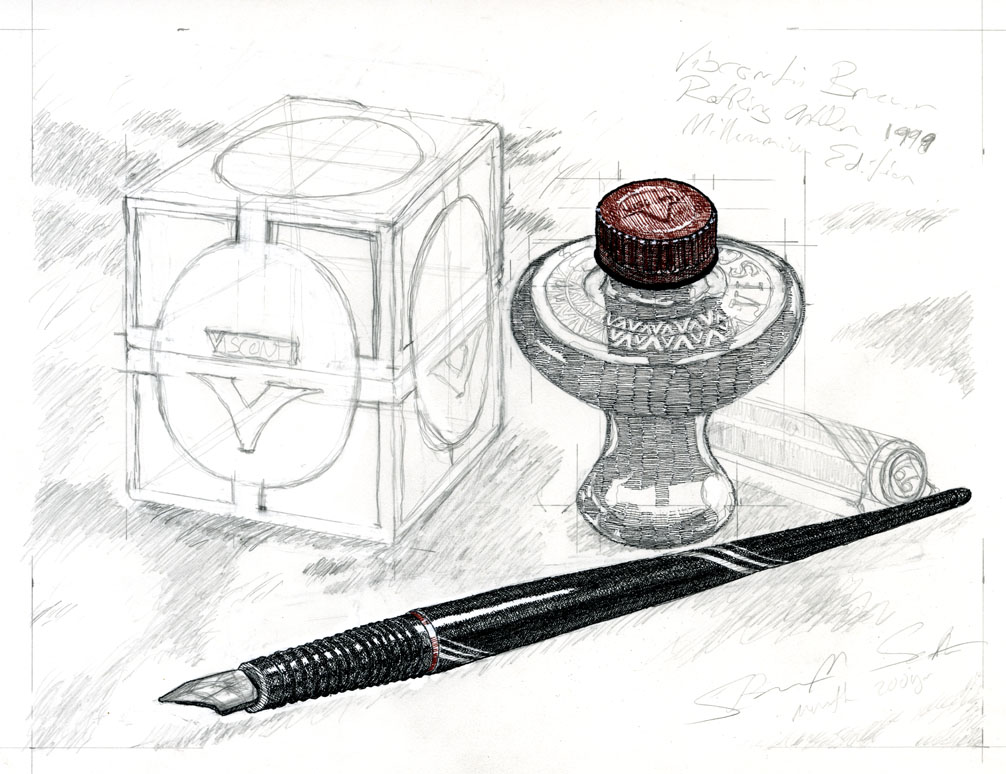
You May Be Right, I May Be Crazy
Last night I stayed in the studio until after midnight when I realized I was parked in a streetcleaning zone and was risking a $35 ticket.
I worked on a few drafts of the background of this Rotring ArtPen and Visconti ink bottle and didn’t come upon a solution, so I went in to the bottle to do the first layer of hatching. That’s as far as I got before remembering I was parked on the Monday side of the street. I decided to do the horizontal hatching since it’s easiest to do tight hatching on the first layerafterwards the previous layers get in the way both visually and in the texture of the paper. The first layer is the darkest area, so the lines won’t be as visible as the lines that will go into the areas that are now unfilled.
I’ve taken to listening to podcasts as I draw. I find it very hard to do any drawing if, for example, the television is on, but the sound of a couple people talking doesn’t get in my way. The part that’s strange is that I can pay attention to what I’m hearing and what I’m doing at the same time. Perhaps the comprehension of spoken words uses different parts of the brain than processing images and relating them to the kinesthetic sense. It’s the only time I believe I’m actually multitasking. If I have a podcast on while I’m writing or programming, I’ll periodically realize that I have no idea what’s been said in the previous few minutes. The focus on linguistic processing for output edges out the unrelated input.
(I’m also a terrible multitasker. I’m very aware that I can’t do two things at onceI can only switch between tasks. My ability to switch between tasks is very poor. I focus on a task, then when I finish, I have to disengage and start thinking in some totally different mode. Some people can switch tasks well and can have a lot of things up in the air. I’m lucky to be able to do three different kinds of things in a day.)
Last night I listened to Art & Story’s fourth episode, «The Big Cop-Out». They were talking about different kinds of shortcuts that they have used, and at one point one or the other of them mentioned people who fill up entire figures with extraneous crosshatching and I had to laugh because leaving whitespace in my drawings is just not something I do very often. I have been accused of spreading the attention in too many directions by providing detail or texture in areas that aren’t focal.
So that got me thinking about my compositions and how I fill them up. Maybe I need to simplify my texture work, maybe do some work with visual shorthand. I don’t know.
What I do know is that I need to start working larger. In order to do these sort of close lines with a 0.13mm rapidograph I have to get right up close to the board. When I leave the studio I can barely see after focusing that close for hours on end. Furthermore, I’m sure that I’d have a better time getting the line qualities that I want, especially with the dip pens. Perhaps even more important, working so small entrenches some bad habits. I end up moving my wrists too much and drawing with my arm not enough.
Unfortunately, I like making prints at the actual size of the drawing, but if I start working larger, I’m going to want to photoreduce the work in order to make prints that will be reasonable for putting on a wall. The only way out is to try one piece larger than usual and see how it works.